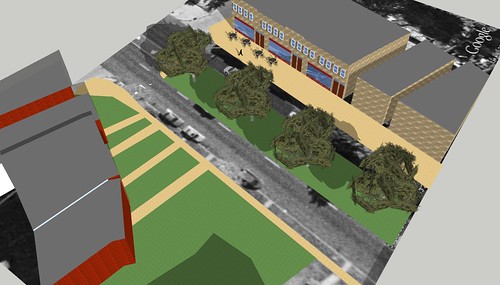In the ten blocks of Chippewa Street located between Ohio on the east and Louisiana on the west is a mostly forgotten and forlorn commercial district. (
Take a Google tour yourself here. Head west with Streetview).
In a shrinking city that has more often opted for suburban style retail to compete with its suburbs, these small traditional business districts don't even get a second look.
Yet if you check out the inventory, there's a lot more there than you might expect. Imagine if some of St. Louis's star mega-entrepreneurs decided to buy up the stretch and market it aggressively (think the Gills with Skinker-DeBaliviere and the Grove or Joe Edwards with the Loop). Chippewa is not the kindest of areas in the city right now, being colloquially located near the epicenter of South Side crime. Yet if circa 2000s Manchester can turn around, I have faith Chippewa can too.
The picture above is the south side of the 2700 block of Chippewa. St. Louis streetcar suburbs (such as this Dutchtown-Gravois Park borderline once was) featured 5 or so primarily north-south residential blocks before interrupting the rows of doubles and 4-families with an east-west mostly-commercial street. See Arsenal, then Cherokee, then Chippewa, then Meramec, Bates, etc.
What is important for re-establishing a neighborhood business district today is the presence of not just corner commercial units (which have often been converted to residential-only anyway) but also mid-block mixed use buildings. These are the buildings that encourage people to continue their journey afoot, convinced that more such beacons of commerce exist farther that way.
Chippewa doesn't have a ton of these, but, as the picture shows above, they're there.
Here's a nice corner commercial building at Chippewa and Ohio. After a little renovation, this could really shine.
Here's a unique corner commercial unit just a block west of those previously shown. Again, a bit of a storefront makeover would go a long way in sprucing up this handsome building (although it might be sad to see those kitchy and in no way appropriate Georgian-style ogee arches over the door disappear).
Hopefully, I'll be able to put together a little map of available properties, since the city seems to have a picture of nearly everything on Chippewa. It has a great stock of both residential and mixed use properties that are simply a little worse for the wear. I'd hate to see it get to the point where more properties are demolished. There's already a large vacant lot in the district as well as an autocentric corner at Compton/Chippewa. Luckily, though, this area is now in the Gravois-Jefferson Historic Streetcar Suburb National Register District, which means that any owner seeking a demolition permit must go through Cultural Resources and the Preservation Board first.
With any luck, this old business district could reconnect with the cluster at Chippewa/Broadway/Jefferson, which has been autocentricized, but not, perhaps, to the point of death. A fine row of commercial buildings,
the subject of much controversy due to Alderman Schmid's liquor license restrictions, sits on the east side of Broadway just south of Chippewa awaiting full occupancy.











